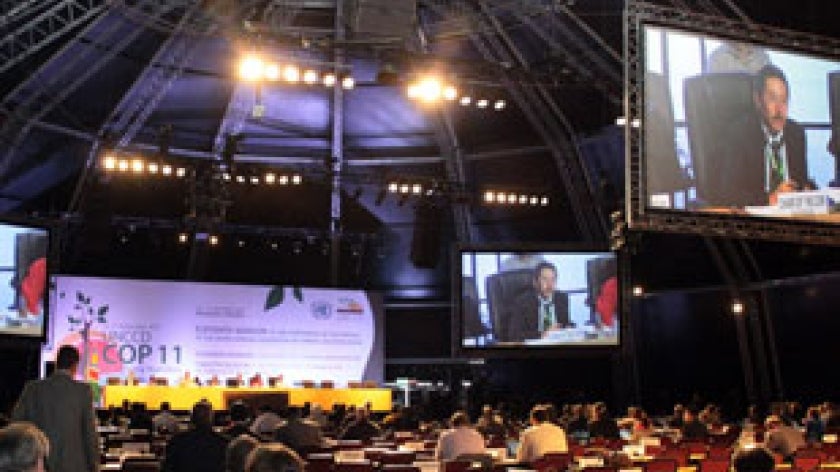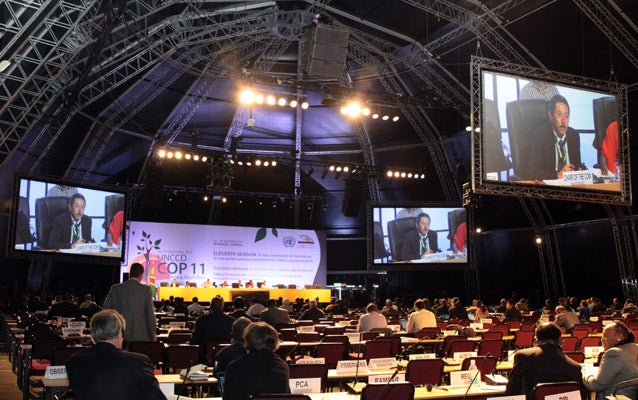

View of the opening plenary, courtesy of IISD/ENB
The eleventh session of the Conference of the Parties to the UN Convention to Combat Desertification opened Monday, 16 September 2013, in Windhoek, Namibia.
COP11 is considering the results of the second UNCCD scientific conference and reviewing the progress of the completion of the first half of the 10-Year Strategy of the UNCCD (2008-2018). Parties will also take decisions on financing, knowledge brokering and the Rio+20 outcome on land degradation, desertification and drought.
COP11 is convened under the theme “A stronger UNCCD for a Land-Degradation Neutral World.” The GEF as a financial mechanism of the convention has an active participation throughout the coming 2 weeks, presenting the GEF report tomorrow Wednesday and organizing a number of side events and meetings with country representatives and NGOs.
To follow the event here a few options:
- See the daily coverage of the event by the Earth Negotiations Bulletin
- Follow it live with the Live webcast of the COP
- Download the COP11 App for Smartphones, the app gives you access to daily schedules, official documents, social media, photos and more (enter the code DRFN)
Rio Pavilion
The GEF as one of the four founding partners of the Rio Conventions Pavilion (RCP) is also participating in many events at the RCP, a series of side events in parallel to the negotiations. Daily coverage of the Rio Pavilion by ENB: http://www.iisd.ca/desert/cop11/pavilion/, or check www.riopavilion.org
The Rio Conventions Pavilion is a platform for raising awareness and sharing information about the latest practices and scientific findings on the co-benefits that can be realized through implementation of the three Rio Conventions.
The Pavilion is a collaborative effort between the Secretariats of the three Rio Conventions and the Global Environment Facility, in addition to a growing list of other global and local partners.
Launched during the International Year of Biodiversity in 2010, the Rio Conventions Pavilion convened at the margins of the CBD Conference of the Parties (CBD COP10) in Nagoya, Japan. The Pavilion has since convened at the UNFCCC COP 16 in Cancun, Mexico, UNCCD COP 10 in Changwon, Republic of Korea, UNFCCC COP 17 in Durban, South Africa, UN Conference on Sustainable Development in Brazil in 2012 ( Rio +20 Earth Summit), and at CBD COP11 in Hyderabad, India. The next Pavilion programme is now taking place at UNCCD COP11 in Windhoek, Namibia.
Through highlighting a number of themes and cross-cutting issues relevant to the three Rio Conventions, and their common objective to support sustainable development and the achievement of the Millennium Development Goals (MDGs), the Pavilion will enable the identification of synergies and co-benefits for the implementation of the three Rio Conventions.
First side event
On the opening day of the conference the GEF has joined the STAP. the Scientific and Technical Advisory Board of the GEF/UNEP for a side event to lead a session featuring the tools developed by the UNEP/GEF "Carbon Benefits Project" at the UNCCD COP 11.
The session provided an in-depth look of the Simple Assessment Tool and the Detailed Assessment Tool. The second half of the session profiled the GEF Agencies' (UNEP, UNDP and IFAD) experiences with the carbon tools in land management projects, and sustainable forest management projects. In particular, the GEF Agencies showcased how they are using the tools to define quantitative baselines, and track progress on achieving carbon sequestration - a global environmental outcome of land management and sustainable forest management projects.
The GEF Agencies also showcased how they are using the tools in land management projects and sustainable management projects to define quantitative baselines, and track progress on achieving carbon sequestration - a global environmental outcome identified in land management projects.
The outcomes of the session demonstrated the GEF Agencies are testing the tools in land management and sustainable forest management projects, and showing the tools are useful for tracking carbon stock changes. The
participants also discussed peatlands, and how the values for the parameters in the tools are not well enough understood. Further research in this area was recommended. Additionally, the discussions featured how the
tools are being used to validate carbon sequestered in projects on payment for ecosystem services. This demonstrates a prospect for using the tools beyond reporting on project achievements.
Find the full report here: http://www.stapgef.org/managing-soil-organic-carbon-for-global-benefits/
The GEF also displays publications and films at the GEF booth in the exhibition center of the COP, a public area that attracts hundreds of local visitors every day.